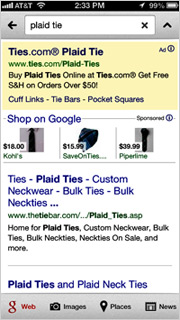Google puts the in-store shopper that much closer to making a purchase via their handset rather than at a retailer with a newly launched mobile extensions of its online Product Listing ad. When a
mobile device enters search terms related to shopping, users will see a sponsored unit containing images and pricing on items as well as links to buy the product on the spot.
The Product
Listing Ad unit has been a part of the desktop Web portfolio for a while, and those who upgrade their accounts to cover enhanced campaigns will automatically have their ads eligible for inclusion in
these sponsored units.
The units are labeled as sponsored and in a “Shop on Google” box. Clicking on any one of the images brings the user into the Google Shop environment
where they can make an immediate purchase, or filter down results of items with various pricing or see further vendor or product information.
This clearly puts Google in the business of
picking off showroomers who are looking for superior deals on what they see in front of them on the shelf. And it also puts Google in more direct competition with one of the best-ranking search
results on any shopping query -- Amazon. VentureBeat blogger John Koestler rightly speculates that this move is also all about Amazon.
 As many studies have shown, the leading e-tailer’s superb apps -- some of which are aimed at product lookups -- usually float to the top of
results, an even more important spot on phones.
As many studies have shown, the leading e-tailer’s superb apps -- some of which are aimed at product lookups -- usually float to the top of
results, an even more important spot on phones.
But Amazon isn’t the only one impacted by this. So is anyone optimizing a retail outlet in search? I have heard some marketers claim that
up to 90% of mobile searchers don’t look beyond the first page of a result. That small span of material is coveted territory. The sample image from Google is a best case scenario on a huge
phone. When I run the same search on iPhone, a large color-coded sponsored post from Ties.com takes up enormous space at the top of results.
The layer of Product Listing Ads comes beneath the
standard sponsored post, and so occupied literally half the screen with ads and leaves room for one organic result. The ads have eaten the content. This may also be a way for Google to push more
mobile-aware retailers into its Product List Ads product as well as its e-shopping and e-wallet fulfillment platforms.